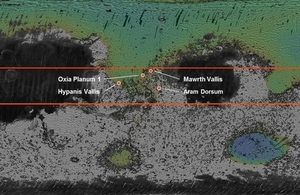Four candidate landing sites for ExoMars 2018
ExoMars is a joint two-mission endeavour between ESA and Russia’s Roscosmos space agency.

Rover landing site candidates. Credit: ESA/Roscosmos/LSSWG.
The Trace Gas Orbiter and an entry, descent and landing demonstrator module, Schiaparelli, will be launched in January 2016, arriving at Mars nine months later. The Rover and Surface Platform will depart in May 2018, with touchdown on Mars in January 2019. The rover will search for evidence of Martian life, past or present.
The search for a suitable landing site for the second mission began in December 2013, when the science community was asked to propose candidates.
The eight proposals were considered during a workshop held by the Landing Site Selection Working Group in April. By the end of the workshop, there were four clear front-runners.
Following additional review by an ESA-appointed panel, the four sites have now been formally recommended for further detailed analysis. The sites – Mawrth Vallis, Oxia Planum, Hypanis Vallis and Aram Dorsum – are all located relatively close to the equator.
The present-day surface of Mars is a hostile place for living organisms, but primitive life may have gained a foothold when the climate was warmer and wetter, between 3.5 billion and 4 billion years ago
says Jorge Vago, ESA’s ExoMars project scientist.
Therefore, our landing site should be in an area with ancient rocks where liquid water was once abundant. Our initial assessment clearly identified four landing sites that are best suited to the mission’s scientific goals.
The area around Mawrth Vallis and nearby Oxia Planum contains one of the largest exposures of rocks on Mars that are older than 3.8 billion years and clay-rich, indicating that water once played a role here. Mawrth Vallis lies on the boundary between the highlands and lowlands and is one of the oldest outflow channels on Mars.
The exposed rocks at both Mawrth Vallis and Oxia Planum have varied compositions, indicating a variety of deposition and wetting environments. In addition, the material of interest has been exposed by erosion only within the last few hundred million years, meaning the rocks are still well preserved against damage from the planet’s harsh radiation and oxidation environment.
By contrast, Hypanis Vallis lies on an exhumed fluvial fan, thought to be the remnant of an ancient river delta at the end of a major valley network. Distinct layers of fine-grained sedimentary rocks provide access to material deposited about 3.45 billion years ago.
ExoMars and the UK
Airbus Defense and Space is the lead builder of the ExoMars rover and SCISYS UK Ltd has been supporting the development of the rover on-board software and its autonomous operations. There is considerable UK involvement from a number of academic institutions with the on-board rover instruments:
PanCam (the panoramic camera system on the rover) is UK-led with scientists from University College London’s Mullard Space Science Laboratory (MSSL) working with the University of Aberystwyth, Birkbeck College and the University of Leicester. PanCam will provide imagery of Mars’ surface that will allow reconstruction by 3-D digital terrain mapping. It will also provide context for drill sampling and rover instrumentation. The wide-angle cameras will provide stereo information while the high-resolution camera will enable close-up images of martian structures and features.
The University of Leicester, Bradford University and STFC Rutherford Appleton Laboratory, are key players in the development of the CCD camera on the Raman Laser Spectrometer (Raman LIBS) which can detect the presence of chemical compounds including minerals and also specific types of “biomarkers” – chemicals indicative of past or present life – that are produced by primitive micro-organisms to enable them to adapt to life in extreme environments. Such organisms are well-known on Earth and probably represent the most likely form of life that could have existed on Mars.
The UK has Co-I involvement on the NOMAD instrument on board the 2016 TGO through the Open University.